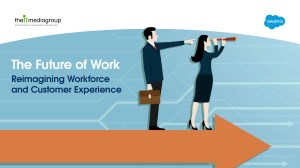3 Ways Canadian CIOs Can Begin Shaping The Future Of Work



Salesforce partnered with the IT Media Group to produce The Future of Work: Reimagining Workforce and Customer Experience. Based on first-hand interviews with CIOs across Canada, it explores the rise of the business-first CIO and their strategic role in reimagining the employee and customer experience.
For decades, a lot of the tools with which CIOs were expected to equip their organization’s workforce were remarkably standardized.
New hires were often given space in a cubicle, and the IT department provided them a desktop PC with word processing or spreadsheet applications, a landline phone and a connection to the Internet.
The role of IT leadership in the past was also largely support-driven. CIOs were responsible for making sure the network didn’t go down very often and that everyday tasks, such as sending jobs to the printer, were as seamless as possible.
With the pandemic, though, the CIO took on a far more dynamic assignment: to help shape the future of work.
This will look a bit different from one organization to the next, but the best way for IT leaders to be successful is to look at common principles and approaches from their peers.
To that end, Salesforce recently partnered with the IT Media Group to produce The Future of Work: Reimagining Workforce and Customer Experience.
Based on first-hand interviews with more than a dozen CIOs across Canada, it identifies 20 different use cases to overcome potential challenges and discover new opportunities. It’s the kind of playbook CIOs have never had, but need.
How The Journey Towards the Future of Work Sped Up
Even before COVID-19 broke out last year, the CIO’s mandate had already undergone a huge transformation.
They were increasingly becoming pivotal in helping companies expand into digital channels. Instead of a top-down approach to provisioning IT, they were trying creative ways to allow a more diverse mixture of devices and applications that were approved for use by individuals and teams. Beyond supporting existing IT, they were turning greater attention to how they could drive innovation.
This includes not only providing technologies to help employees be more productive or efficient, but evaluating IT investments with a goal of fostering greater collaboration as companies seek to let employees work from anywhere. Technology shouldn’t just get the job done, but help employees support customers throughout their journey with a brand.
The “future of work” isn’t just limited to those CIOs serve. The role of IT leadership is evolving too, where CIOs need to think of themselves as accelerating the pace of change.
CIOs can no longer be the execs who say “No” to new tools based on security concerns or the challenges of integrating them. They need to become the people who help organizations live out their purpose and mission with the best solutions available.
As the IT Media Group report shows, there are a few things about the future of work that CIOs can count on — and which should inform the work they do from here on in:
1. What Was Once ‘The IT Strategy’ Needs To Become A People Strategy
CIOs have historically made purchasing decisions based on whether it could solve a business problem, whether it fit within their budget and how quickly they could measure return on investment (ROI).
Those are all still important considerations, but none of them speak specifically to the impact on people.
The report includes stories from furniture manufacturers such as Teknion to financial services firms such as Manulife about the connection between technology and its impact on the employee experience.
CIOs can make IT decisions that help reduce sick days, boost a feeling of belonging among the team and fuel engagement even when staff are working remotely.
2. ’Customer Satisfaction’ Becomes An IT Metric Vs. ‘Output’ or ‘Uptime’
IT conversations can often get mired into speeds and feeds, such as how fast a microprocessor runs or how a platform can scale to manage a larger volume of data. Yet CIOs are beginning to realize that their definition of “success” is based more on numbers that were once seen as the jurisdiction of other business functions.
Many of the organizations featured in the report, such as Loblaw Companies Ltd., Equitable Bank and KTC Canada, are evaluating the progress of their digital transformation based on how it:
-
Removes friction for customers to do what they want
-
Accommodates emerging desires to do more online and at home
-
Allows them to learn and anticipate needs through artificial intelligence and machine learning
3. The Tech Stack Is Only As Good As The Experience The Organization Can Deliver
Apparel companies like Canada Goose and real estate firms like Avison Young may seem to have little in common at a first glance. Yet their IT leaders are both shining examples in the report of how CIOs are doing a lot more than simply acquiring and deploying technology.
By adopting a more data-driven approach, CIOs are becoming increasingly focused on what happens after deployment. This could include how a customer takes a more proactive role in the experience the company offers, or how the company can work in ways that align customers’ most important values, such as sustainability.
Perhaps more than almost any other executive besides the CEO, CIOs can make their mark on both the experience of both the employee as well as the customer every employee serves.
That means the scope of what Canadian CIOs can accomplish for their organization is much broader than ever before. The future of their work is really about unleashing the ability for everyone else to do their best work, and for customers to have a better experience as a result.
These three points are only some of the takeaways you’ll find as part of The Future of Work: Reimagining Workforce and Customer Experience. Download the full report to get a comprehensive deep-dive into the priorities and lessons learned from IT leaders across a diverse range of industries.






















